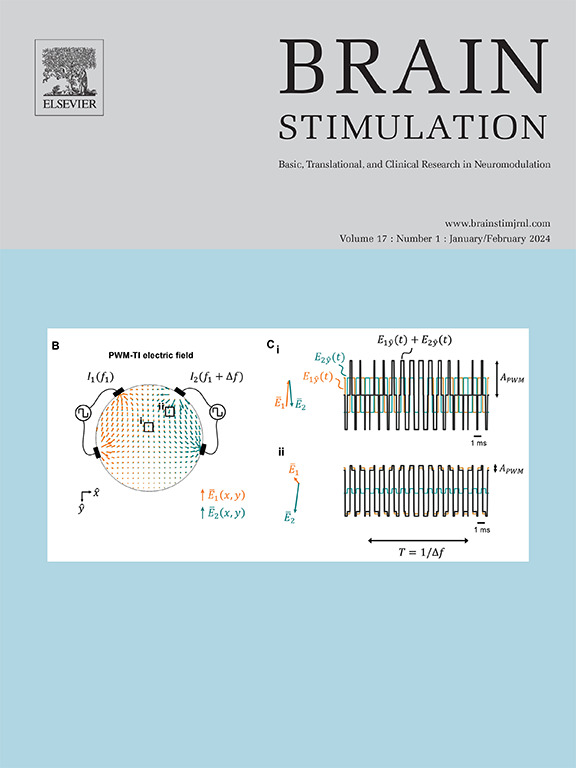伴随抗惊厥药物与抑郁症电惊厥治疗的临床和认知结果之间的关系
IF 8.4
1区 医学
Q1 CLINICAL NEUROLOGY
引用次数: 0
摘要
背景:联合使用抗惊厥药物对电惊厥治疗(ECT)结果的影响尚不明确,之前的研究结果不一致。本研究考察了同时使用抗惊厥药与ECT治疗抑郁症的临床和认知结果之间的关系。方法对2016年12月至2024年6月期间因ICD-10单极或双相抑郁发作而开始急性电痉挛治疗的511名成年住院患者进行回顾性队列研究。结果包括最终ECT后的临床整体印象改善(CGI-I),每次治疗后的重新定向时间,每次治疗后的脑电图(EEG)和运动发作持续时间。使用有序逻辑回归、混合效应参数生存模型和线性混合效应模型对数据进行分析。结果511名参与者中,107名(20.9%)在ect前基线接受抗惊厥药物治疗。同时使用抗惊厥药与CGI-I的治疗结果显著较差相关(校正优势比= 1.60,95% CI: 1.05-2.44, p = 0.028)。相反,与未服用抗惊厥药物的患者相比,服用抗惊厥药物的患者定向明显更快(校正风险比= 1.42,95% CI: 1.12-1.80, p = 0.004),在ECT前不服用夜间抗惊厥药物的患者也是如此(校正风险比= 1.24,95% CI: 1.02-1.51, p = 0.028)。在非滴定疗程中,抗惊厥药的使用与脑电图或运动癫痫发作持续时间无显著相关。结论:在接受ECT治疗的抑郁症患者中,同时使用抗惊厥药物与较差的临床反应相关,尽管治疗后立即恢复定向的速度略快。在ECT中使用抗惊厥药物需要仔细的临床考虑。本文章由计算机程序翻译,如有差异,请以英文原文为准。
Association between concomitant anticonvulsants and clinical and cognitive outcomes of electroconvulsive therapy for depression
Background
The impact of concomitant anticonvulsant medications on electroconvulsive therapy (ECT) outcomes is not firmly established, with previous studies yielding inconsistent results. This study examined associations between concomitant anticonvulsant use and clinical and cognitive outcomes of ECT for depression.
Methods
A retrospective cohort study was conducted in 511 adult inpatients who initiated an acute ECT course for an ICD-10 unipolar or bipolar depressive episode between December 2016 and June 2024. Outcomes included Clinical Global Impression – Improvement (CGI-I) after final ECT, time to reorientation after each session, and electroencephalographic (EEG) and motor seizure duration after each session. Data were analysed using ordinal logistic regression, mixed-effects parametric survival models, and linear mixed-effects models.
Results
Of the 511 participants, 107 (20.9 %) were receiving anticonvulsants at pre-ECT baseline. Concomitant anticonvulsant use was associated with a significantly less favourable therapeutic outcome on the CGI-I (adjusted odds ratio = 1.60, 95 % CI: 1.05–2.44, p = 0.028). Conversely, patients on anticonvulsants reoriented significantly faster (adjusted hazard ratio = 1.42, 95 % CI: 1.12–1.80, p = 0.004), as did those whose nighttime dose of anticonvulsant was withheld before ECT (adjusted hazard ratio = 1.24, 95 % CI: 1.02–1.51, p = 0.028), compared to those not on anticonvulsants. Anticonvulsant use was not significantly associated with EEG or motor seizure duration in non-titration sessions.
Conclusions
Concomitant use of anticonvulsants in patients treated with ECT for depression was associated with worse clinical response, despite a marginally faster recovery of orientation immediately after treatment sessions. Use of anticonvulsants during ECT requires careful clinical consideration.
求助全文
通过发布文献求助,成功后即可免费获取论文全文。
去求助
来源期刊

Brain Stimulation
医学-临床神经学
CiteScore
13.10
自引率
9.10%
发文量
256
审稿时长
72 days
期刊介绍:
Brain Stimulation publishes on the entire field of brain stimulation, including noninvasive and invasive techniques and technologies that alter brain function through the use of electrical, magnetic, radiowave, or focally targeted pharmacologic stimulation.
Brain Stimulation aims to be the premier journal for publication of original research in the field of neuromodulation. The journal includes: a) Original articles; b) Short Communications; c) Invited and original reviews; d) Technology and methodological perspectives (reviews of new devices, description of new methods, etc.); and e) Letters to the Editor. Special issues of the journal will be considered based on scientific merit.
 求助内容:
求助内容: 应助结果提醒方式:
应助结果提醒方式:


